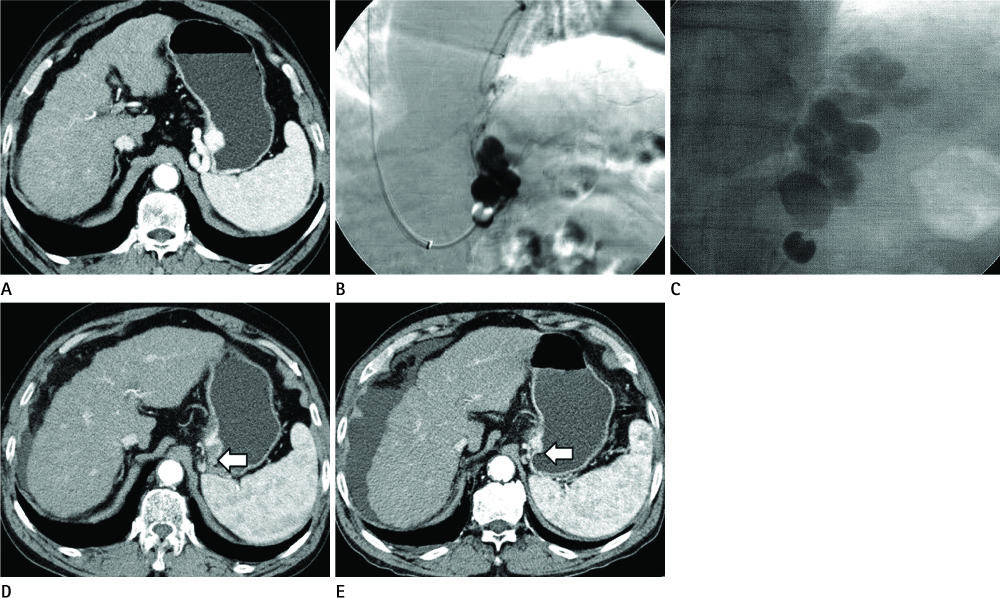J Korean Soc Radiol.
2011 Oct;65(4):357-363. 10.3348/jksr.2011.65.4.357.
Comparison of Coil Embolization and Slcerotherapy of Collateral Veins during Balloon Occluded Retrograde Transvenous Obliteration: Its Long Term Effect for Gastric Varix Treatment
- Affiliations
-
- 1Department of Radiology, Dongsan Medical Center, Keimyung University College of Medicine, Daegu, Korea. yhkim68@dsmc.or.kr
- KMID: 2002936
- DOI: http://doi.org/10.3348/jksr.2011.65.4.357
Abstract
- PURPOSE
We compared the long term effect gastric varix treatment between coil embolization and sclerotherapy of collateral veins during balloon occluded retrograde transvenous obliteration (BRTO).
MATERIALS AND METHODS
Between February 2004 and November 2008 48 patients with gastric varix bleeding successfully treated with BRTO 23 underwent embolization of collateral veins during BRTO were enrolled in this study. In patients, collateral veins were embolized with the use of microcoil (group 1). Agent (5% ethanolamine oleate + lipiodol) was used in the remaining 7 patients (Group 2). Recurrence and rebleeding of gastric varix were evaluated by endoscopy or CT.
RESULTS
Gastric varix recurred in 4 patients (17.4%) and rebleeding occurred in 2 (8.7%). Recurrence (57.1%, p = 0.001) and rebleeding (28.6%, p = 0.029) of gastric occurred in group 2. CT finding within 6 months in partial or complete thrombosis without lipiodol uptake in gastric varix, gastric varix recurred on follow up CT.
CONCLUSION
Coil embolization of collateral veins during BRTO may promote complete obliteration of gastric varix, provide lower recurrence and rebleeding rates of gastric sclerosing agent on long term follow-up.
MeSH Terms
Figure
Reference
-
1. Kim YH, Seong CK, Kim YJ, Shin TB, Park NH, Choi JS. Balloon-occluded retrograde transvenous obliteration for gastric variceal bleeding patient. J Korean Soc Radiol. 2003; 48:225–233.2. Kim ES, Park SY, Kwon KT, Lee DS, Park MJ, Chung IK, et al. The clinical usefulness of balloon occluded retrograde transvenous obliteration in gastric variceal bleeding. Korean J Hepatol. 2003; 9:315–323.3. Hirota S, Matsumoto S, Tomita M, Sako M, Kono M. Retrograde transvenous obliteration of gastric varices. Radiology. 1999; 211:349–356.4. Kiyosue H, Mori H, Matsumoto S, Yamada Y, Hori Y, Okino Y. Transcatheter obliteration of gastric varices. Part 1. Anatomic classification. Radiographics. 2003; 23:911–920.5. Kiyosue H, Mori H, Matsumoto S, Yamada Y, Hori Y, Okino Y. Transcatheter obliteration of gastric varices: Part 2. Strategy and techniques based on hemodynamic features. Radiographics. 2003; 23:921–937. discussion 937.6. Kanagawa H, Mima S, Kouyama H, Mizuo H, Iziri M, Tanabe T, et al. [A successfully treated case of fundic varices by retrograde transvenous obliteration with balloon]. Nihon Shokakibyo Gakkai Zasshi. 1991; 88:1459–1462.7. Kanagawa H, Mima S, Kouyama H, Gotoh K, Uchida T, Okuda K. Treatment of gastric fundal varices by balloon-occluded retrograde transvenous obliteration. J Gastroenterol Hepatol. 1996; 11:51–58.8. Sonomura T, Sato M, Kishi K, Terada M, Shioyama Y, Kimura M, et al. Balloon-occluded retrograde transvenous obliteration for gastric varices: a feasibility study. Cardiovasc Intervent Radiol. 1998; 21:27–30.9. Kawanaka H, Ohta M, Hashizume M, Tomikawa M, Higashi H, Kishihara F, et al. Portosystemic encephalopathy treated with balloon-occluded retrograde transvenous obliteration. Am J Gastroenterol. 1995; 90:508–510.10. Akahane T, Iwasaki T, Kobayashi N, Tanabe N, Takahashi N, Gama H, et al. Changes in liver function parameters after occlusion of gastrorenal shunts with balloon-occluded retrograde transvenous obliteration. Am J Gastroenterol. 1997; 92:1026–1030.11. Ninoi T, Nishida N, Kaminou T, Sakai Y, Kitayama T, Hamuro M, et al. Balloon-occluded retrograde transvenous obliteration of gastric varices with gastrorenal shunt: long-term follow-up in 78 patients. AJR Am J Roentgenol. 2005; 184:1340–1346.12. Fukuda T, Hirota S, Sugimura K. Long-term results of balloon-occluded retrograde transvenous obliteration for the treatment of gastric varices and hepatic encephalopathy. J Vasc Interv Radiol. 2001; 12:327–336.13. Park KS, Kim YH, Choi JS, Hwang JS, Kwon JH, Jang BK, et al. [Therapeutic efficacy of balloon-occluded retrograde transvenous obliteration in patients with gastric variceal bleeding]. Korean J Gastroenterol. 2006; 47:370–378.14. Kim JH, Kim YH, An EJ, Kim SH, Choi JS. CT finding after BRTO in patients with gastric varix bleeding: can we predict varix recurrence. J Korean Soc Radiol. 2011; 64:131–137.
- Full Text Links
- Actions
-
Cited
- CITED
-
- Close
- Share
- Similar articles
-
- Plug-Assisted Retrograde Transvenous Obliteration for the Treatment of Gastric Varix with Both Gastrorenal and Gastrocaval Shunts: A Case Report
- Balloon Occluded Retrograde Transvenous Obliteration of Bleeding Stomal Varices Using Sodium Tetradecyl Sulfate Foam: A Case Report
- Successful Treatment of Duodenal Variceal Bleeding with Coil-Assisted Retrograde Transvenous Obliteration: A Case Report
- Gastric variceal hemorrhage treated with percutaneous transhepatic embolization with balloon-occluded antegrade transvenous obliteration
- CT Findings after BRTO in Patients with Gastric Varix Bleeding: Can We Predict Varix Recurrence



